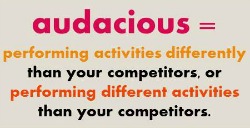 I’ve spent the past six months thinking intently about what the most critical factors are in creating marketing success. With so much marketing advice to be found in books and on the interwebs, it’s so easy to fall into the trap of chasing the latest marketing “solution.”
I’ve spent the past six months thinking intently about what the most critical factors are in creating marketing success. With so much marketing advice to be found in books and on the interwebs, it’s so easy to fall into the trap of chasing the latest marketing “solution.”
Whether it’s the newest social media site or tool, mastering calls-to-action, offers, landing pages, copywriting, storytelling techniques, inbound marketing, content development, launches, SEO, link building, paid-search, ad infinitum, marketing can be overwhelming if you are not focused on the biggest drivers of success.
With this state of overwhelm, I’ve been thinking hard about what’s really really REALLY important versus what’s more speculative or more advanced. Call it trying to make the complex more simple, or call it applying the Pareto Principle to marketing. Either way, it’s about getting focused on the few activities that make the most difference in your ability to attract and retain customers.
What I’ve come up with are based on my own years in leading consumer products and retail brands large and small, creating programs that grow sales, profits and market share, and of course, in reviewing, analyzing and dissecting countless case studies in hundreds of industries and sectors.
I want to reiterate, my definition of success is growing sales and profits. If you’re more comfortable defining success as creating engagement, or launching campaigns that go viral, or in racking up thousands of social media fans, followers or comments, or receiving awards, then my list may not be complete for you.
These are the 5 areas I believe you need focus on to achieve success or improve your business results:
1) Strengthen your points-of-difference
2) Promote, promote, promote
3) Steal ideas from outside your industry and make them yours
4) Test and learn
5) Be hungry for success
Strengthen your points-of-difference
As you might expect from somebody who encourages marketers to be audacious, having a strong point-of-difference is absolutely critical and number one on my list. I’m old school and still use the term Unique Selling Proposition (“USP”) to address this area. What you call it, however, is not as important as having one. What’s your answer to the question: “Why should people give you money instead of to others, or instead of doing nothing different?” If you don’t have a good answer to this, or if you find competitors have more compelling benefits they are offering your customers, you need to work on improving yours.
Promote
I define promotion as the act of making offers. This can be in television or mass media advertising, or it can be in a simple Facebook post. It can be to highlight a new product that has taken you years to develop, or it can be to highlight a core product you started your company with. It’s the action of marketing communications. Obviously, what you communicate and how you communicate it will define how successful it is, but if you aren’t making offers, nobody will notice you.
Steal
This is a loaded word, that makes some I mention it to squeamish and uncomfortable, while it makes others giddy with childish laughter. Please note, I am not advocating breaking the law. I am merely asserting that ideas are abundant when you benchmark outside of your own industry. Whether you find a copywriting phrase you can adopt, a novel way of showcasing your products in a new context, or identifying new channels of distribution, practiced innovation requires you to look beyond your immediate competitors to find new ideas.
Test and Learn
Whether you’ve identified a new USP, or a new way to promote, or a new product to launch, you can increase your chances of success using market research. The idea here is to test small, validate or iterate (until you have a winning idea), then launch big.
To me, market research serves two critical needs: 1) It helps you validate that the changes you want to make are desirable by your customers and prospects. If you don’t please the customers, they won’t give you their money; 2) It helps minimize risk. Risk is not the probability of failure. If you get to an audacious position where you’re testing lots of ideas, then you need to accept that many will fail. Instead, risk is the amount of money you could lose x the probability of failure. [See test test small, validate or iterate (until you have a winning idea), then launch big above.]
Be Hungry
This is the most intangible of my 5 areas and right now is the hardest for me to articulate and advocate with clarity. For now, let’s suffice to say that it’s about being relentless in pursuit of your goal, and not accepting failure as an end, but rather as a stepping stone for more changes. There’s something here in terms of having an “immigrant’s mentality” that I will be exploring more, but for now, let’s summarize it using the words of the late college basketball coach Jimmy Valvano “Don't give up, don't ever give up.”